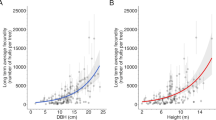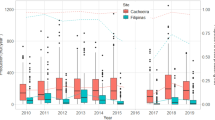Abstract
We examined the spatial structure of fruit yield, tree size, vigor, and soil properties for an established pear orchard using Moran’s I, geographically weighted regression (GWR) and variogram analysis to determine potential scales of the factors affecting spatial variation. The spatial structure differed somewhat between the tree-based measurements (yield, size and vigor) and the soil properties. Yield, trunk cross-sectional area (TCSA) and normalized difference vegetation index (NDVI, used as a surrogate for vigor) were strongly spatially clustered as indicated by the global Moran’s I for these measurements. The autocorrelation between trees (determined by applying a localized Moran’s I) was greater in some areas than others, suggesting possible management by zones. The variogram ranges for TCSA and yield were 30–45 m, respectively, but large nugget variances indicated considerable variability from tree to tree. The variogram ranges of NDVI varied from about 14–27 m. The soil properties copper, iron, organic matter and total exchange capacity (TEC) were spatially structured, with longer variogram ranges than those of the tree characteristics: 31–95 m. Boron, pH and zinc were not spatially correlated. The GWR analyses supported the results from the other analyses indicating that assumptions of strict stationarity might be violated, so regression models fitted to the entire dataset might not be fitted optimally to spatial clusters of the data.






Similar content being viewed by others
References
Akaike, H. (1974). A new look at the statistical model identification. IEEE Transactions on Automatic Control, 19, 716–723.
Anselin, L. (1995). Local indicators of spatial association—LISA. Geographical Analysis, 27, 93–115.
Anselin, L., & Kelejian, H. H. (1997). Testing for spatial error autocorrelation in the presence of endogenous regressors. International Regional Science Review, 20, 153–182.
Beran, R., & Hall, P. (1992). Estimating coefficient distributions in random coefficient regressions. Annals of Statistics, 20, 1970–1984.
Bramley, R. G. V., & Hamilton, R. P. (2004). Understanding variability in winegrape production systems. 1. Within vineyard variation in yield over several vintages. Australian Journal of Grape and Wine Research, 10, 32–45.
Brunsdon, C., Fotheringham, S., & Charlton, M. (1998). Geographically weighted regression-modelling spatial non-stationarity. The Statistician, 47, 431–443.
Castrignanò, A., Buttafuoco, G., & Puddu, R. (2008). Multi-scale assessment of the risk of soil salinization in an area of south-eastern Sardinia (Italy). Precision Agriculture, 9, 17–31.
Cliff, A. D., & Ord, J. K. (1981). Spatial properties: Models and applications (pp. 19–21). London, England: Pion.
Cressie, N. A. C. (1993). Statistics for spatial data, revised edition. New York: Wiley.
Deutsch, C. V., & Journel, A. G. (1998). GSLIB: Geostatistical software library and user’s guide. New York, USA: Oxford University Press.
Fotheringham, S. A., Brunsdon, C., & Charlton, M. (2000). Quantitative geography, perspectives on spatial data analysis. London, England: Sage Publications.
Fotheringham, S. A., Brunsdon, C., & Charlton, M. (2002). Geographically weighted regression: The analysis of spatially varying relationships. Chichester, England: Wiley.
Hope, A. C. A. (1968). A simplified Monte Carlo significance test procedure. Journal of the Royal Statistical Society Series B, 3, 582–598.
Hurvitch, C. M., Siminoff, J. S., & Tsai, C. L. (1998). Smoothing parameter selection in nonparametric regression using an improved Akaike information criterion. Journal of the Royal Statistical Society Series B, 60, 271–293.
Johnson, L. F., Roczen, D. E., Youkhana, S. K., Nemani, R. R., & Bosch, D. F. (2003). Mapping vineyard leaf area with multispectral satellite imagery. Computers and Electronics in Agriculture, 38, 33–44.
Kerry, R., & Oliver, M. A. (2007). Comparing sampling needs for variograms of soil properties computed by the method of moments and residual maximum likelihood. Geoderma, 140, 383–396.
Lahiri, S. N., Lee, Y., & Cressie, N. (2002). On asymptotic distribution and asymptotic efficiency of least squares estimators of spatial variogram parameters. Journal of Statistical Planning and Inference, 103, 65–85.
Lamb, D. W., Weedon, M. M., & Bramley, R. G. V. (2004). Using remote sensing to predict grape phenolics and colour at harvest in a Cabernet Sauvignon vineyard: Timing observations against vine phenology and optimising image resolution. Australian Journal of Grape and Wine Research, 10, 46–54.
Matheron, G. (1963). Principles of geostatistics. Economic Geology, 58, 1246–1266.
Matheron, G. (1965). Les variables régionalisées et leur estimation. Paris: Masson et Cie.
Moran, P. A. P. (1948). The interpretation of statistical maps. Journal of the Royal Statistical Society Series B, 10, 243–251.
Oregon State University. (2005) Archived climate data from Hood River Exp’l Station. http://www.ocs.oregonstate.edu/index.html
Pardo-Igúzquiza, E. (1997). MLREML: A computer program for the inference of spatial covariance parameters by maximum likelihood and restricted maximum likelihood. Computers and Geosciences, 23, 153–162.
Pardo-Igúzquiza, E. (1998). Inference of spatial indicator covariance parameters by maximum likelihood using MLREML. Computers and Geosciences, 24, 453–464.
Payne, R. W., Murray, D. A., Harding, S. A., Baird, D. B., & Soutar, D. M. (2008). GenStat for windows (11th Edition) introduction. Hemel Hempstead, England: VSN International.
Plant, R. E. (2001). Site-specific management: The application of information technology to crop production. Computers and Electronics in Agriculture, 30, 9–29.
Pozdnyakova, L., Gimenez, D., & Oudemans, P. V. (2005). Spatial analysis of cranberry yield at three scales. Agronomy Journal, 97, 49–57.
Rouse, J. W., Haas, R. H., Schell, J. A., Deering, D. W., & Harlan, J. C. (1974). Monitoring the vernal advancements and retrogradation of natural vegetation. Greenbelt, MD: NASA/GSFC final report, 371 pp.
Schabenberger, O., & Gotway, C. A. (2005a). Statistical methods for spatial data analysis. Chapter 2: Some theory on random fields (p. 43). Boca Raton, FL: Chapman and Hall.
Schabenberger, O., & Gotway, C. A. (2005b). Statistical methods for spatial data analysis. Chapter 8: Non-stationary covariance (pp. 425–426). Boca Raton, FL: Chapman and Hall.
Tumbo, S. D., Whitney, J. D., Miller, W. M., & Wheaton, T. A. (2002). Development and testing of a citrus yield monitor. Applied Engineering in Agriculture, 18, 399–403.
Wang, C., Färe, R., & Seavert, C. F. (2006). Revenue capacity efficiency of pear trees and its decomposition. Journal of the American Society for Horticultural Science, 131, 32–40.
Whelan, B. M., & McBratney, A. B. (2001). The ‘‘null hypothesis’’ of precision agriculture management. Precision Agriculture, 2, 265–279.
Whitney, J. D., Ling, Q., Wheaton, T. A., & Miller, W. M. (2001a). A DGPS yield monitoring system for Florida citrus. Applied Engineering in Agriculture, 17, 115–119.
Whitney, J. D., Ling, Q., Wheaton, T. A., & Miller, W. M. (2001b). A citrus harvesting labor tracking and yield mapping system. Applied Engineering in Agriculture, 17, 121–125.
Zaman, Q.-U., & Schumann, A. W. (2006). Nutrient management zones for citrus based on variation in soil properties and tree performance. Precision Agriculture, 7, 45–63.
Acknowledgments
Funding for this research came from the USDA CSREES Initiative for Future Agriculture and Food Systems (IFAFS) Grant No. 2001-52103-11323. The satellite imagery utilized in this work was acquired through the NASA Scientific Data Purchase by staff at the NASA John C. Stennis Space Center Earth Science Applications Directorate. The authors are grateful to Dr. Frank Yin of the University of Tennessee, Department of Plant Sciences for the use of soils data from the research site. We are also indebted to Professor Margaret Oliver for the generous assistance in variogram analysis, and all of the reviewers who provided their perspectives on the work.
Author information
Authors and Affiliations
Corresponding author
Rights and permissions
About this article
Cite this article
Perry, E.M., Dezzani, R.J., Seavert, C.F. et al. Spatial variation in tree characteristics and yield in a pear orchard. Precision Agric 11, 42–60 (2010). https://doi.org/10.1007/s11119-009-9113-5
Published:
Issue Date:
DOI: https://doi.org/10.1007/s11119-009-9113-5




